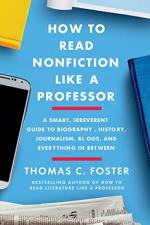
|
| Name: _________________________ | Period: ___________________ |
This test consists of 5 short answer questions, 10 short essay questions, and 1 (of 3) essay topics.
Short Answer Questions
1. In Chapter 14, "The Universe of Ideas/Ideas of the Universe," what does Foster say is true about contemporary America?
2. In Chapter 15, "Reading Internet Sources," what does Foster say the contemporary world lacks?
3. In Chapter 10, "From the Inside Out," which claim does Foster make about thesis statements?
4. In Chapter 9, "Living the News," which work does Foster say is likely the first example of New Journalism?
5. In Chapter 12, "Life from the Inside," why does Foster think Ambrose chose Merriwether Lewis's perspective for his history Undaunted Courage?
Short Essay Questions
1. In Chapter 13, "On the Stump," what concern does Foster say that other journalists have about Wolff's work?
2. In Chapter 9, "Living the News," why does Foster say that Hunter S. Thomson's Fear and Loathing in Las Vegas is really a roman à clef?
3. In Chapter 13, "On the Stump," what are the three categories that Foster says outsider exposés fall into, and why does he say that they are more reliable than insider's writings?
4. In Chapter 14, "The Universe of Ideas/Ideas of the Universe," what qualities does Foster say a genuine expert will have?
5. In Chapter 9, "Living the News," why does Foster say that Woodward and Bernstein do not belong in the category of New Journalism?
6. In Chapter 14, "The Universe of Ideas/Ideas of the Universe," what does Foster say motivates antiscientific beliefs?
7. In Chapter 15, "Reading Internet Sources," Foster reveals the central issue of the book. What does he say the issue is, and why does he believe it is worth devoting a book to?
8. In Chapter 11, "Life from the Inside," what does Foster say is the difference between autobiography and memoir?
9. In Chapter 11, "Life from the Inside," why does Foster spend time describing the contents of Cardinal Newman's autobiography?
10. In Chapter 12, "That Is So Last Year," what difference does Foster explain between primary and secondary sources?
Essay Topics
Write an essay for ONE of the following topics:
Essay Topic 1
In Chapter 6, "Source Code," Foster suggests that as microfiche research is time-consuming and frustrating, writers should use secondary sources such as biographies. Offer an evaluation of this argument. Be sure to consider the assumptions Foster is making about both primary and secondary sources and the applicability of his suggestion to nonfiction in fields outside of history--such as science, sociology, the arts, politics, and so on.
Essay Topic 2
On page 28 of Chapter 2, "The Ecology of the Nonfiction Biosphere," Foster writes the following paragraph:
"That's easy: time. The thing of which there is never enough. That heals all wounds or possibly wounds all heels."
Analyze the effectiveness of this paragraph. What rhetorical strategies are at work here? What do you believe to be its purpose? Does it accomplish its purpose?
Essay Topic 3
Choose a passage of one of Hunter S. Thompson's essays to analyze. Explain the techniques Thompson uses that are more commonly associated with fiction than with nonfiction, and explain the relationship between your observations and Foster's remarks about Thompson's writing in Chapter 9, "Living the News."
|
This section contains 1,020 words (approx. 4 pages at 300 words per page) |

|




